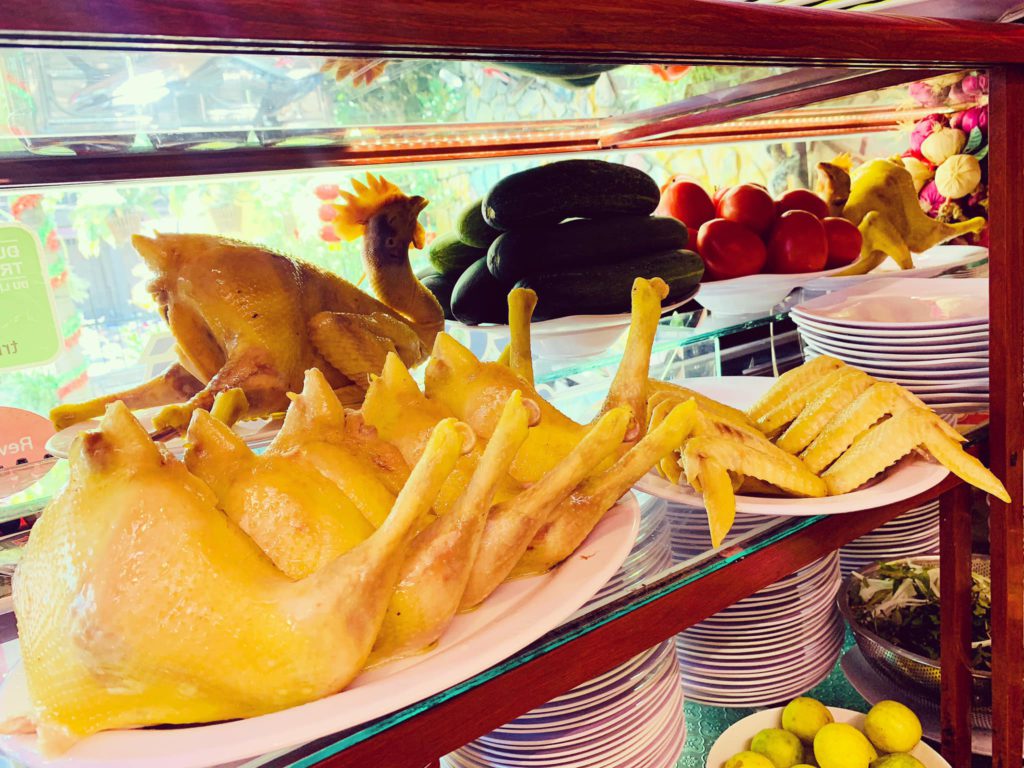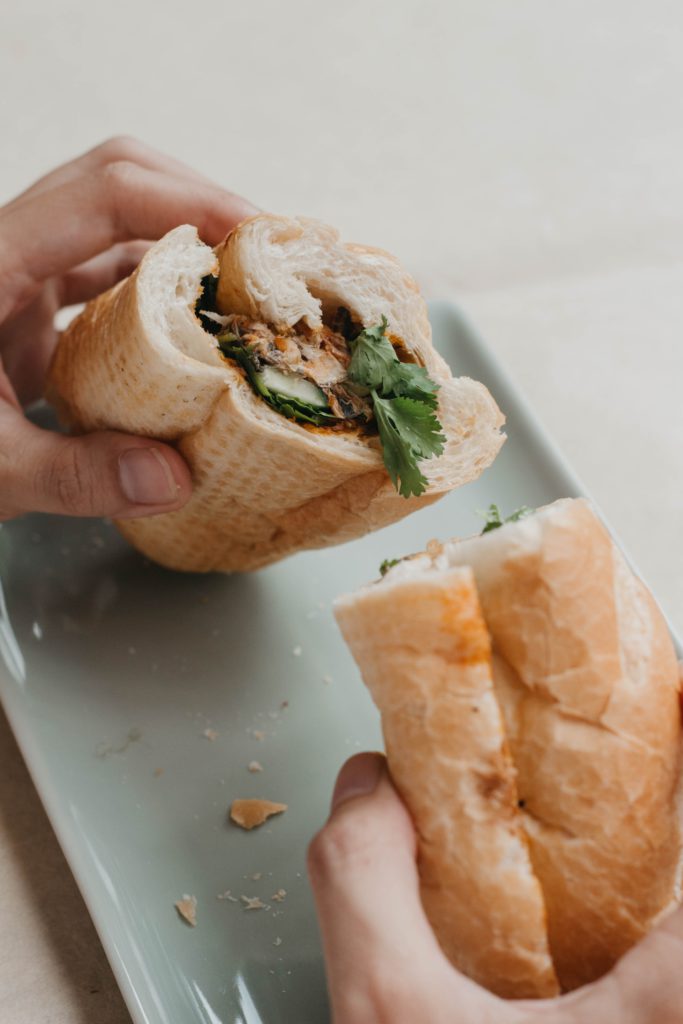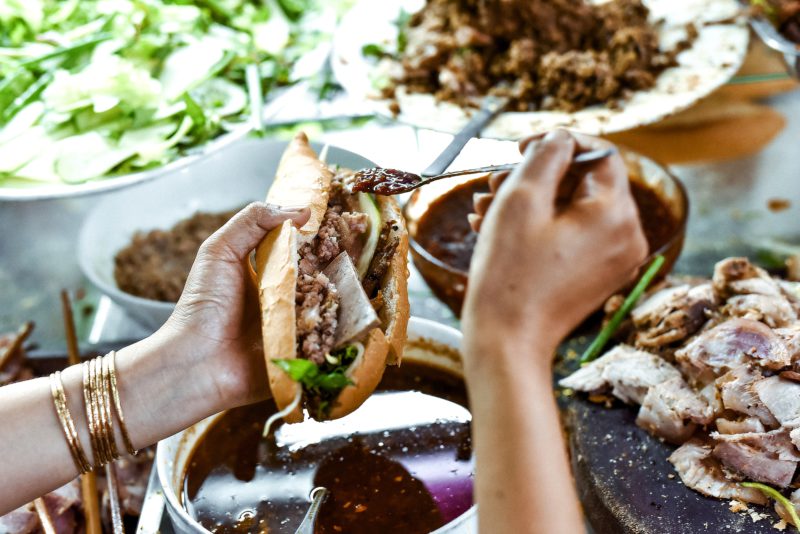Table of Contents
Vietnamese food hasn’t conquered the world in the same way that Indian or Chinese food has. But as anyone who has dived into a plate of com ga (chicken rice) or gotten fat on banh xeo (savory Vietnamese pancakes) will know: it’s just a matter of time. The Vietnamese know how to get a heap of flavor from minimal ingredients, and the dishes are healthy too! You’ll find each region has its own local specialties, and Hoi An is no exception. Its history as a major trading port combined with its place on the river play a big part in the cuisine. Equip yourself with an empty belly and make sure you find the following top 10 tasty Hoi An foods when you’re passing through the city!
Cau lao
Cau lao is perhaps the most famous Hoi An food, and you won’t find it anywhere else. It’s a noodle-based foodstuff, made by just a handful of families. Its scarcity is down to the fact that a genuine cau lao must be prepared with well-water drawn from the local area. The noodles are also mixed with ash from the melaleuca tree, grown across the water on Cham Island.
There are many different noodles found in Vietnam, but cau lao is by far the “meatiest”. It’s a chewy and wholesome noodle, resembling a thick spaghetti. The dish itself is prepared with both fatty and crispy pork, spices, green salad, and a minimal chili sauce. A great dish at any time of day, but often sold out after lunch — these noodles are made in relatively small batches.
Where to find Cau lao in Hoi An: Thanh Cau Lao, 26 Thai Phien, Minh An
Com ga

Chicken rice may not sound like much, but the simplicity of the ingredients combined with a zingy spice mix makes this a treat for the taste buds. Chicken is shredded thinly, mixed with rice, Vietnamese coriander, chili, mint, pickled carrot, and papaya, all drizzled with fresh lime juice.
There are a few different variations that you can find around Hoi An. For the genuine article, stick to the streets and seek out Long Com Ga. It’s hidden down an alleyway but has both indoor and outdoor seating. The crowd of locals who flock to this site on a daily basis tells you everything you need to know! A wonderfully-filling Hoi An dish for lunch or dinner.
Where to find com ga in Hoi An: Long Com Ga, 53/16 Phan Chu Trinh, Minh An
Banh bao ban vac
White rose dumplings are another special Hoi An food. They’re also made by a single family. Tran Tuan Ngai owns the aptly-named White Rose Restaurant, and also supplies these unique dumplings to a select group of other eateries.
Named after the flower they resemble, banh bao banh vac are made from rice paper and filled with shrimp, onion, beansprouts, mushrooms and a drizzle of sauce. Unlike other dumplings that you’ll find in Hoi An, the white rose is “open”. Their shape was designed for the ingredients to fit inside, without the need for a lid. Treat yourself and save these for dinner.
Where to find banh bao banh vac in Hoi An: White Rose Restaurant, 533D Hai Ba Trung, Cam Pho
Banh mi

Banh mi are not exclusive to Hoi An, but every region of Vietnam has their own style and Hoi An’s are perhaps the tastiest you’ll find. Introduced to Vietnam by the French, the Hoi An baguette resembles the French-version more than others you’ll find across the country. Crispy and tapered at both ends, it’s the little things that make a difference!
You can find banh mi almost everywhere you look in Hoi An, and the quality is high wherever you buy. Search them out early. Although you can find some great vendors who will sell these around lunch or dinnertime, it’s for breakfast around 6 am that banh mi is designed for.
You’ll find a range of fillings including pork, cheese, eggs, grilled meat, or a combination of all of them. Some recipes have been tweaked for the tourist market, but a genuine banh mi should have pickled carrots and papaya, cucumber, chilli and no lettuce. The true secret of a great banh mi is in the secret sauce. Every vendor makes their own and they’re all different. It’s the unique sauce that keeps loyal customers visiting the same stall, day-in, day-out.
Following celebrity chef Anthony Bourdain’s recommendation, Banh Mi Phuong on 2b Phan Chu Trinh Street sells the most famous sandwiches in Hoi An. But for something a little different — and to avoid the queues — pay Phi Banh Mi a visit. They’re also open all day!
Where to find banh mi in Hoi An: Phi Banh Mi, 88 Thai Phien, Minh An
Banh dap
You’ll see rice crackers across Vietnam. In the north, they’re often served with beer and peanuts. Banh dap is a version exclusively found in Hoi An. True banh dap is a combination of two rice crackers placed together like a sandwich.
The bottom layer is spread with chili and onion sauce until it goes slightly soggy. Top with a dry cracker, smash into bite-size pieces, dip into fish sauce, et voila! You now have a deliciously salty, spicy munch that’s perfect for snacking on whilst drinking a beer or two.
For best results, grab some banh dap in the late afternoon, sit by the river, and watch the sun go down as the fishermen return for their dinner.
Where to find banh dap in Hoi An: Banh Dap Hoi An, 679 Hai Ba Trung, Cam Pho
Che bap
Sweet soup is a common dessert in Vietnam. Visit a che stall and you’ll have a great selection of beans, nuts, and seeds to choose from, all topped off with coconut cream and ice. However, the local che bap variation predominantly uses corn, and comes from Cam Nam island.
You won’t have to swim or take a boat to get there — just cross the stone bridge by Hoi An’s Central Market. Che bap sellers are everywhere on Cam Nam, and you’ll also find it in most of the island’s restaurants. Eat whenever you need a sweet yet healthy treat.
Where to find che bap in Hoi An: Ben Tre Restaurant, Xuyen Trung, Cam Nam
Banh xoai
First things first: this mango cake is not a cake, nor does it contain mangoes! The name itself derives from the shape of this gloriously moreish treat. These mini mango-shaped delights are made from a rice flour dough and contain crushed peanuts and sugar. They’re sold on the main streets in Hoi An’s Old Town and on An Hoi islet, and cost around 50,000 VND for four. Best eaten on a shopping stroll around the Old Town, after dark.
Where to find banh xoai in Hoi An: Various street vendors in the Old Town and on An Hoi islet
Banh xeo
As with banh mi, banh xeo are not an exclusive Hoi An food. But you’ll find the best ones here. Smaller, thinner, and crunchier than those found in the south, they’re a Vietnamese pancake made from rice flour batter, served with salad, beansprouts, and sometimes meat or fish.
Everything is served separately and you have the fun of putting everything together yourself. Get a local person to show you how to roll, and be prepared to get your fingers very messy. But don’t leave Hoi An without a proper bellyful! These are totally delicious and make a fabulous lunch or dinner.
Where to find banh xeo in Hoi An: Hai Son Vietnamese Pancake Restaurant, 143 Ly Thai To, Cam Son
Mi quang
Named after Quang Nam province in which Hoi An resides, mi quang noodles are almost as famous as cau lao. You can find mi quang at selected places in the north and south, but like all local foodstuffs, they’re best eaten straight from the source.
Mi quang is popular for breakfast and consists of long flat noodles, not dissimilar to tagliatelle pasta. There are many variations but classic Hoi An mi quang will usually include shrimp, pork, and vegetables, served on salad leaves and topped with crispy rice paper. Like cau lao, the sauce is minimal and quite spicy.
Where to find mi quang in Hoi An: Ong Hai, 6A Truong Minh Luong, Cam Chau
Hen xuc banh trang
Hen xuc banh trang are another rice paper Hoi An dish, with this variation being native to Cam Nam. Much of the population of this small island is involved in the fishing industry, whether as fishermen, boat makers, or restaurant-owners, and this dish is a true reflection of island life.
The rice paper here is used as a scoop, similar to papadum in Indian cooking. The basis of the dish is locally-sourced clams, often harvested right next to the very restaurant at which you’re dining. The clams are mashed up with local vegetables and a spice mix. The dish is very popular with bia hoi, locally brewed fresh beer. Go for these in the afternoon.
Where to find hen xuc banh trang in Hoi An: Banh Dap So 9, Luong Nhu Bich, Cam Nam
We hope you have fun getting full on these delectable Hoi An foods! Check out our ultimate Vietnam food guide for more inspiration.
About TourHero
TourHero is a social travel platform that enables you to travel with like-minded people and fall in love with the journey. We work closely with handpicked local operators to ensure every experience curated is unique and exclusive to your travel group. Come with us on epic adventures and create memories that last a lifetime!








